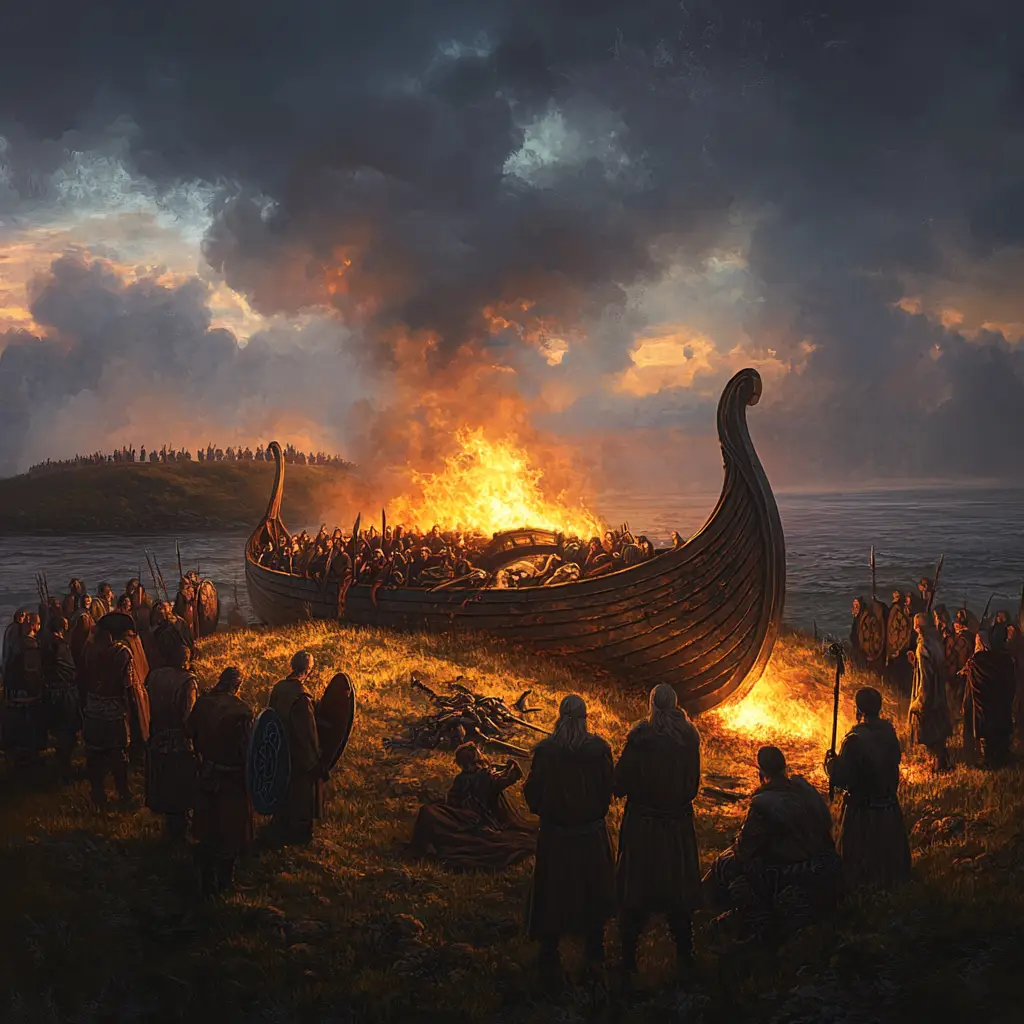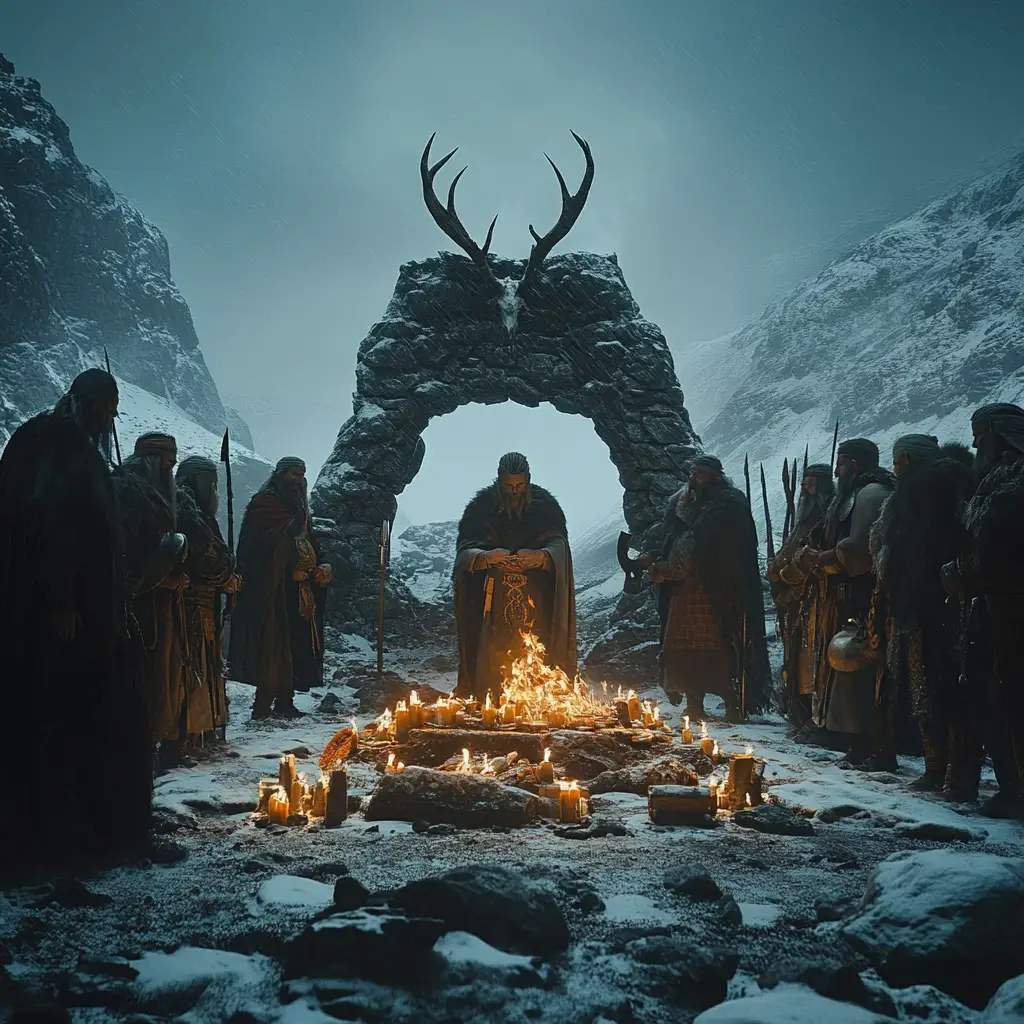Viking customs and rituals were deeply tied to their beliefs in the gods, the afterlife, and the importance of community. Here’s a closer look at some of the key customs and rituals that played a major role in Viking culture:
Blóts (Sacrificial Rituals)
Purpose: Blóts were performed to honour the gods and ensure prosperity in various aspects of life, such as successful harvests, victories in battle, or protection for the community.
What Happened: These rituals often involved sacrificing animals—such as horses, pigs, or cattle—and sometimes humans (though human sacrifices were rarer). The sacrifices were made in the name of a specific god, like Odin, Thor, or Freyja.
Celebration: After the sacrifices, a feast would typically follow where the community would celebrate and give thanks for the gods’ favour.
Funerary Customs
Ship Burials: Prominent Vikings, such as warriors or chieftains, were sometimes buried in ships, which were either buried in the ground or set afloat and burned. The ships were filled with valuable items such as weapons, shields, and tools to assist the deceased in the afterlife.
Grave Goods: Regardless of whether the burial was in a ship or not, it was common for the deceased to be buried with goods like jewellery, weapons, and sometimes even animals. This was believed to ensure a comfortable afterlife.
Funeral Feasts: Funerals often involved large feasts with the community gathering to honour the deceased. In some cases, the funeral could involve ritual sacrifice, including offerings to the gods to ensure a safe passage to the afterlife.
The Thing (The Assembly)
Purpose: The Thing was a public assembly where Vikings would gather to make decisions, pass laws, and settle disputes. Every free man had the right to attend and voice his opinion.
Rituals of Justice: The Thing was a place where legal cases were heard, and judgments were made. It was both a social and political event that embodied the Viking sense of justice and equality.
Rituals of Vows: Oaths taken at the Thing were considered sacred, with violators subject to severe consequences, including outlawry or death.
Vows and Oaths
Sacred Bonds: Oaths and vows were an essential part of Viking culture, especially regarding loyalty to leaders or kin. Breaking an oath could lead to dishonour and punishment.
Blood Oaths: Warriors sometimes swore blood oaths with their comrades or leaders. These oaths bound them together in battle and loyalty until death, with betrayal considered a grave dishonour.
Revenge and Blood Feuds: The Vikings believed in avenging wrongs, particularly the deaths of close family members. This led to the concept of blood feuds, where families would seek revenge for any perceived dishonour.
The Sacrificial Feasts
Purpose: Feasts were a significant part of Viking rituals, particularly after a battle or during religious festivals. These feasts were held to honour gods, celebrate victories, or mark seasonal changes.
The Mead: Mead, a drink made from fermented honey, was consumed during feasts and was often believed to have divine properties. It was sometimes used as an offering to the gods.
Celebration of the Dead: Viking communities would hold feasts to honour the spirits of the dead. These rituals helped maintain a connection between the living and the deceased, ensuring protection and guidance from the ancestral spirits.
Sowing and Harvest Rituals
Farming Festivals: The Vikings had rituals to ensure good crops and successful harvests. These rituals often involved making offerings to the fertility gods, such as Freyja or Freyr, in hopes of abundant crops and prosperity.
Midwinter and Mid-summer Celebrations: Festivals tied to the changing seasons, such as Yule (the winter solstice) and Midsummer, were important times for Viking communities to gather and celebrate with sacrifices and feasts.
Ragnarok and the Afterlife
Valhalla: The Vikings believed that fallen warriors who died bravely in battle would be chosen by the Valkyries to enter Valhalla, a great hall where they would fight and feast until the end of the world.
Hel: For those who did not die in battle, they believed in an underworld realm called Hel, ruled by the goddess Hel. The afterlife in Hel was a more sombre place, a realm for those who had lived an unremarkable life.
Ancestor Worship: Vikings also revered their ancestors and believed that they had an ongoing presence in their lives. Ancestor worship involved rituals to honour the dead and seek their guidance or protection.
Naming and Birth Rituals
Naming After Gods or Ancestors: Names held significant meaning in Viking society. Children were often named after gods or ancestors, carrying with them the hopes and traits of those figures.
Rites of Passage: As children grew, they underwent rites of passage, particularly those involving the transition from childhood to adulthood. Boys, for example, would typically receive their first weapons around the age of 12, symbolizing their readiness to become warriors.
Seidr (Viking Sorcery)
Seers and Shamans: Seidr was a form of Norse magic, often practiced by women known as “völvas” or seeresses. They would engage in rituals to predict the future or manipulate events.
Odin’s Role: Odin, the chief of the gods, was closely associated with knowledge and magic. He is said to have sacrificed an eye to gain wisdom and practiced seidr himself.
Warrior Code and Battle Rituals
Sacred Battles: The Vikings were known for their warrior culture. Before battle, rituals and prayers would be conducted to invoke the gods for victory and protection. Warriors would often paint or mark their bodies to prepare mentally and spiritually for the battle ahead.
Sacrificing for Victory: Before raids, warriors would sometimes sacrifice animals to ensure the gods’ favour. These sacrifices were believed to strengthen their position and enhance their odds of success in battle.
The Vikings’ rituals and customs helped form a powerful, closely-knit society where honour, bravery, and respect for the gods and the dead were central to daily life. Their belief in an afterlife, gods, and ancestral connections profoundly influenced their behaviour, both in life and in death.



